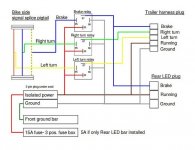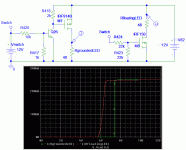Hi all,
I need some expertise on transistors and I think this is the place to find it.
I bought a motorcycle with all LED lights and want to pull a trailer with LED lights. Very simple to do with the circuit below.
However I can't help but think it would be better with transistors instead of relays.
What are you opinions and couldn't I just do this with a few transistors mounted on an aluminum plate dead bug style with a single small pcb on top?
Any help or positive criticism would be appreciated,
Troy

I need some expertise on transistors and I think this is the place to find it.
I bought a motorcycle with all LED lights and want to pull a trailer with LED lights. Very simple to do with the circuit below.
However I can't help but think it would be better with transistors instead of relays.
What are you opinions and couldn't I just do this with a few transistors mounted on an aluminum plate dead bug style with a single small pcb on top?
Any help or positive criticism would be appreciated,
Troy

couldn't I just do this with a few transistors mounted on an aluminum plate
dead bug style with a single small pcb on top?
I would use all standard automotive parts (like the relays), since they are intended
for rugged vibration and temperature, and will have fewer parts and connections
to go bad.
....think it would be better with transistors instead of relays.....
Why? My Honda cars, 2002 and 1996, are FULL of these relays. One chatters bad to tell me my O2 sensor is dying. I know the '02 has never had a relay failure, and I doubt the '96 has. Total of like 10,000 hours between them, which is a LOT for a motorcycle. Relays are Proven Technology.
OTOH... are there ANY specs on the parts you propose??
The relay may be 2W-4W. AFAICT nobody says what an LED taillight is worth in power because it is so tiny compared to an 1157 incandescent. My guesses run 3W-5W. It is not much more load on the brake/turn switches to wire the LED direct than to relay it with a conventional 30A car relay.
Unless the bike has had a major wires-up redesign in the last decade, the switches are probably good for 30 Watts of incandescents and will not be strained by a double-set of 5W LEDs. (However if I am wrong, I'm sure the replacement switch will be hard to get and costly....)
$184 each? Ouch.
I will make a pcb similar to this, but I still think it can be done simpler with silicon.
https://www.amazon.com/gp/aw/d/B077V8V6HC/ref=ox_sc_act_image_1?smid=A1OB26G8TSLEZQ&psc=1
Conventional tail-lights return current through the shell and the vehicle bodywork. This needs a "high side" switch. For negative-ground systems without a boosted voltage we need a P-type transistor. P-types often cost more for their spec, but negligible in context of a motorcycle which can pull a trailer.
The simple single power device is an inverter. The application wants non-inverting. Another transistor is needed.
I modeled the LED module as a 48 Ohm resistor, 0.25A at 12V. For simulation I modeled the brake/turn switch source as a 0-12V source; even though "it is always zero or 12V" actually it must ramp, also we want to know if it may be marginal in extreme conditions.
Remember that a "12V" motor-thing supply may be 10V or 15V, and can have spikes to +/-100V. We need to survive the spikes and try to function when limping home on a dead dynamo.
Q26 M7 seems to work. The extra resistors hold things off when switch is disconnected, and resist spikes. Q26 is "any NPN", you can pull some from a dead VCR or Sansui. M7 should be P-MOSFET >5A >100V in a TO220, preferably insulated. It will run stone-cold unless something goes wrong; things go wrong so I'd use a generous part and bolt it to something, noting that the tab is "lamp hot" and can not touch motorcycle metal.
Input turn-on is 7V-8V for zero C to 50 C temperature, and nominal 12V system will always work it. (At 8V the LED is liable to be quitting, also modern bike ECU and other vital functions.)
Most LED tail-lights do NOT use the shell as return path, but are 2-wire floating. This opens the possibility of low-side switching. I do not like this! It is utterly non-standard and will befuddle many mechanics, even you when you stumble out late at night and find no lights. It also needs a constant-hot 12V wire in the harness, which is non-standard, and potentially dangerous. However this does save the extra transistor to invert logic. The MOSFET is now P-type, specs as for high-side. Turn-on is about 6.3V.
The Gate pins and any conductor hanging from it must be SHORT! Relay is modest gain to 200Hz, MOSFET is HIGH gain to GHz, and an inch of wire will induce oscillation. In dead-bug you can do very short.
Since we are where we are: these are *switching* MOSFETs, not some "AUDIO!" type you found in fancy amplifiers. While most audio MOSFET amps finesse switch-FETs into linear, there were a few real-linear FETs made. They switch, but not as good. And should cost a lot. These should be generic $1-$2 MOSFETs.
The simple single power device is an inverter. The application wants non-inverting. Another transistor is needed.
I modeled the LED module as a 48 Ohm resistor, 0.25A at 12V. For simulation I modeled the brake/turn switch source as a 0-12V source; even though "it is always zero or 12V" actually it must ramp, also we want to know if it may be marginal in extreme conditions.
Remember that a "12V" motor-thing supply may be 10V or 15V, and can have spikes to +/-100V. We need to survive the spikes and try to function when limping home on a dead dynamo.
Q26 M7 seems to work. The extra resistors hold things off when switch is disconnected, and resist spikes. Q26 is "any NPN", you can pull some from a dead VCR or Sansui. M7 should be P-MOSFET >5A >100V in a TO220, preferably insulated. It will run stone-cold unless something goes wrong; things go wrong so I'd use a generous part and bolt it to something, noting that the tab is "lamp hot" and can not touch motorcycle metal.
Input turn-on is 7V-8V for zero C to 50 C temperature, and nominal 12V system will always work it. (At 8V the LED is liable to be quitting, also modern bike ECU and other vital functions.)
Most LED tail-lights do NOT use the shell as return path, but are 2-wire floating. This opens the possibility of low-side switching. I do not like this! It is utterly non-standard and will befuddle many mechanics, even you when you stumble out late at night and find no lights. It also needs a constant-hot 12V wire in the harness, which is non-standard, and potentially dangerous. However this does save the extra transistor to invert logic. The MOSFET is now P-type, specs as for high-side. Turn-on is about 6.3V.
The Gate pins and any conductor hanging from it must be SHORT! Relay is modest gain to 200Hz, MOSFET is HIGH gain to GHz, and an inch of wire will induce oscillation. In dead-bug you can do very short.
Since we are where we are: these are *switching* MOSFETs, not some "AUDIO!" type you found in fancy amplifiers. While most audio MOSFET amps finesse switch-FETs into linear, there were a few real-linear FETs made. They switch, but not as good. And should cost a lot. These should be generic $1-$2 MOSFETs.
Attachments
Please give me a minute ( or a few hours) to digest your post.
However this is not a "standard automotive electrical system ".
It was fully designed as an all LED low current system. It does not use the chassis as return it uses 2 wire for every circuit bit it is still 12v negative ground..
Honda CTX1300..
However this is not a "standard automotive electrical system ".
It was fully designed as an all LED low current system. It does not use the chassis as return it uses 2 wire for every circuit bit it is still 12v negative ground..
Honda CTX1300..
Last edited:
- Status
- This old topic is closed. If you want to reopen this topic, contact a moderator using the "Report Post" button.
- Home
- General Interest
- Everything Else
- Cross-over technology and not talking passive or active:-)
